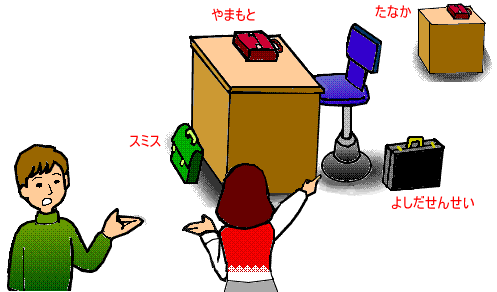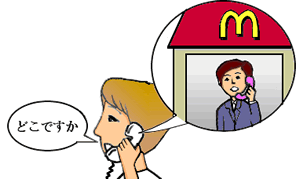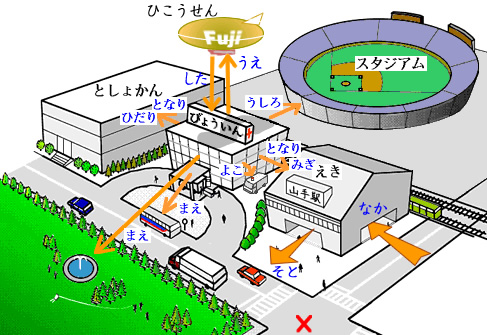|
 この, その, あの, どの この, その, あの, どの |
| |
この, その, and あの prenominal forms of demonstrative pronouns.
That is, these words are used only to modify a noun and cannot
be used as a noun by themselves ( below ). below ).
|
|
|
| この |
へや |
は |
あかるいですね。 |
This room is bright. |
| その |
バス |
は |
べんりですね。 |
That bus (near you) is convenient. |
| あの |
トラック |
は |
おおきいですね。 |
That truck (over there) is large. |
| どの |
コンピュータ |
|
ですか。 |
Which computer is it? |
 この この |
|
は |
コンピュータです。 |
[ungrammatical] |
 その その |
|
は |
コンピュータです。 |
[ungrammatical] |
 あの あの |
|
は |
コンピュータです。 |
[ungrammatical] |
 どの どの |
|
は |
コンピュータですか。 |
[ungrammatical] |
Note that adjectives (or noun + の like 日本人の) may be inserted after a prenominal form before the noun.

modifies |
"this tall person" |
|

modifies |
"that Japanese teacher" |
その can also be used to refer to something/someone that is mentioned in the previous sentence as shown below.
| A: |
よしださんの せんこうは えいごです。 |
Ms. Yoshida's major is English. |
| B: |
そのひとは にほんじんですか。 |
Is that person (= he/she) a Japanese? |
どの is the prenominal question word
which means "which." To ask which one X is, you can use
the pattern Xは どのNですか . Compare this with another question word どれ which means "which one". どの and どれ are not interchangeable. どの is a prenominal form (i.e., occurs only in front of a noun) and cannot become a noun by itself while どれ is a noun by itself.
| |
|
| たなかさんの くるまは |
どの くるま |
ですか。 |
Which car is Mr. Tanaka's car? |
|
あの くるま |
です。 |
It's that car. |
| ぎんこうは |
どの たてもの |
ですか。 |
Which building is the bank? |
| |
あの たてもの |
です。 |
It's that building. |
|
|
| たなかさんの くるまは |
どれ |
ですか。 |
Which one is Mr. Tanaka's car? |
| たなかさんの くるまは |
どの |
ですか。 |
[Ungrammatical] |
The demonstrative pronouns (これ, それ, あれ and どれ) we learned in Lesson
4 are regular pronouns and cannot be used to modify a noun. This
fact makes all of the following ungrammatical.
|
 Xの Xの |
| |
The pronoun の ("one") is used to substitute another
noun (usually referring to objects, not people) and create a shorter
expression. For example, in English, "a white car" can
be shortened to "a white one." The same can be done in
Japanese.
| |
| あたらしい |
コンピュータ |
→ |
あたらしい |
の |
new one |
| むずかしい |
ほん |
→ |
むずかしい |
の |
difficult one |
| しろい |
くるま |
→ |
しろい |
の |
white one |
| ひまな |
ひと |
→ |
ひまな |
の |
idle one;
one who is not busy |
Examples in sentences are shown below.
| あの しろい |
のは |
としょかん |
です。 |
That white one is the library. |
With the NのN construction, the particle の and the
pronoun の are rolled into one の.
| Noun |
の |
Noun |
|
Noun |
の |
|
| きのう |
の |
コーヒー |
→ |
きのう |
の |
yesterday's (one) |
| きょねん |
の |
くるま |
→ |
きょねん |
の |
last year's (one) |
Since the structure PERSON の N expresses a possessive notion "PERSON's N," this can be shortened to PERSON の "PERSON's."
| たなかさんの かばんは |
どれですか。 |
Which one is Mr. Tanaka's bag? |
| わたしのは |
あおい のです。 |
Mine is the blue one. |
| |
あおい のです。 |
It's the blue one. |
The following combinations (on the left) are ungrammatical. The correct form is written on the right.
- Ungrammatical → Grammatical
- *この の → これ ("this one")
- *その の → それ ("that one [near you]")
- *あの の → あれ ("that one [far away]")
- *どの の → どれ ("which one?")
|
|
 はが はが |
| |
There are two ways to ask "Which person is Mike?" (1) マイクさんは どのひとですか and (2) どのひとが マイクさんですか. The first type of sentences contains the particle は (topic marker) while the second type contains the particle が (subject marker). Both of these sentence types consist of an unknown/new element and a known element but they are structured in the opposite order. The particle は marks something as a known topic that is previously introduced into the conversation or assumed to be known while the particle が marks something as unknown or new and can follow a question word (e.g., どのひと). Remember this rule: The topic marker は can NEVER mark a question word while が (and other particles like を, に, etc.) can mark a question word.
|
|
| |
|
|
|
|
|
|
|
| マイクさん |
は |
どのひとですか。 |
どのひと |
が |
マイクさんですか。 |
| As for Mike |
|
which person is it? |
Which person |
|
is Mike? |
| マイクさん |
は |
あのひとです。 |
あのひと |
が |
マイクさんです。 |
| Mike |
|
is that person. |
That person |
|
is Mike. |
| |
|
あのひとです。 |
あのひと |
|
です。 |
| (It) |
|
is that person. |
|
That person |
|
is. |
The answer to a WHが-question must be also marked by が. One seeks unknown information with a WH question (A1) and the other gives new information as its answer (B1). If one refers to the same entity mentioned previously (A2), は must be used instead of が. (Xは=English "it/he/she/they" or "the X")
どのひとが アリスさんですか。 ("Which person is Alice?")
このしろいTシャツのひとが アリスさんです。 ("This person with a white T-shirt is Alice.")
そのひとは せがひくいですか。 ("Is she short?")
はい、せがひくいです。 ("Yes, she is short.")
In other words, は functions to keep the same topic while が introduces new information (often to change the topic). Compare the following conversations. かた ("person") below is the polite form of ひと. (New information is in bold/red. Known information is underlined.)
- あのかたは マイクさんですか。 "Is that person Mike?"
いいえ、あのかたは ジョンさんです。 "No, he is John."
- あのかたが マイクさんですか。 "Is that person (over there) Mike?"
いいえ、そのかたが マイクさんです。 "No, that person (near you) is Mike."
|
| |
The adjective たかい means "high." To describe
a person's height, you have to use a special form of this adjective せが たかい "tall" or せが ひくい "short (in
height)." This adjective corresponds to different adjectives
in English. By adding いちばん in front of the adjective, we can create superlative expression ("the most ~") as in いちばん たかい("the most expensive") or いちばん やすい くるま ("the cheapest car").
| あのひとは せが たかいですね。 |
That person is tall. |
| あのビルは たかいですね。 |
That building is tall. |
| このくるまは たかいですね。 |
This car is expensive. |
| いちばん おおきいのは アメリカのくるまです。 |
The largest one is an American car. |
| あのくるまが いちばん やすいです。 |
That car is the cheapest. |
| アメリカのくるまが いちばん おおきいです。 |
American cars are the largest. |
Note that Sentences 5 and 6 above use が which marks あのくるま and アメリカの くるま as the newly introduced information in conversation. If あの くるま and アメリカの くるま are previously introduced in conversation, these should be marked by は instead as in あの くるまは~ and アメリカの くるまは~, respectively.
|
|
| |
The question word だれ ("who?") refers to a person and works like another question word どれ ("which one?"). To ask "Whose X", we use だれのX as shown below.
| あのひとは だれですか。 |
Who is that person? |
| あのかたは すずきせんせいです。 |
He/She is Professor Suzuki. |
| あのかばんは だれの かばんですか。 |
Whose bag is that bag? |
| どれですか。 |
Which one (do you mean)? |
| その みどりの かばんです。 |
That green bag. |
| それは リーさんのですよ。 |
That's Mr. Lee's. |
| よしださんのは どれですか。 |
Which one is Ms. Yoshida's? |
| あれですよ。あの あかいのです。 |
It's that one. That red one. |
 |
|
| |
The demonstrative pronouns (ここ, そこ, あそこ, どこ) refer to specific
locations near or far from the speaker and/or listener.
| ここ |
here (near me) |
this place |
| そこ |
there (near you) |
that place (near you) |
| あそこ |
over there (far away) |
that place far away |
| どこ |
where |
which place |
The copula です can be used in the sense of "Something/Someone
is located" as shown below.
| |
|
| がくせいかいかん |
は |
どこ |
ですか。 |
Where is Student Center? |
| がくせいかいかん |
は |
あそこ |
です。 |
Student Center is over there. |
| |
|
あそこ |
です。 |
(It) is over there. |
| ブラウンさん |
は |
どこ |
ですか。 |
Where is Ms. Brown? |
| ブラウンさん |
は |
にほん |
です。 |
Ms. Brown is in Japan. |
| |
|
にほん |
です。 |
(She) is in Japan. |
Earlier, we learned the structure Xは Yです "X is Y."
If Y refers to a place, this structure can be used to state the
location of someone or something: "X is located in Y."
For example, わたしは マクドナルドです can mean "I'm at McDonald's
(restaurant)" as in Picture 1 or "I am McDonald"
as in Picture 2.
 |
 |
Picture 1 |
Picture 2 |
|
| |
Two different types of location expressions are introduced here. In Type 1 expression, A1 below asks WHAT is located in the dorm by the Locationに Xが あります pattern. The last word ありますis the verb that states that an inanimate
object (not people or animals) is located somewhere. In this pattern, the particle が marks X as something new/unknown---not previously introduced in conversation. The topic marker は can be inserted after に as in りょうには~ if the "dormitory" is already established as a known location/topic.
| |
| |
| |
| りょう |
に(は) |
なに |
が |
ありますか。 |
What is (located) in the dorm? |
| |
|
キッチン |
が |
あります。 |
A kitchen is (located) there. |
| |
|
|
キッチン |
です。 |
A kitchen is. (short version) |
 Note that the particle が is dropped here. Note that the particle が is dropped here.
In Type 2 expression, A2 below asks WHERE the cafeteria is located by Xは Locationに あります pattern. In this pattern, the particle は marks X as the information previously introduced (i.e., the topic = "cafeteria") in conversation. In reply, B2 can just say 2かいに あります. (Note that は can NEVER be placed after に here because it is following a question word (e.g., どこ).)
| |
| |
| |
| カフェテリア |
は |
どこ |
に |
ありますか。 |
Where is the cafeteria (located)? |
| (それ |
は) |
にかい |
に |
あります。 |
It is (located) on the second floor. |
| |
|
にかい |
です。 |
It's on the second floor. |
 Note that the particle に is dropped in the short version. Note that the particle に is dropped in the short version.
The verb あります can also be used to refer to an abstract existence of something instead of physical objects as in しつもんがあります ("I have a question").
- しつもんが ありますか。 ("Do you have any questions?")
- いいえ、ありません。 ("No, I don't.")
|
| |
In English, the part of speech is marked by the word order as in /Subject + Verb + Object/. In Japanese, this is done by particles. Noun phrases (/noun + particle/) within verb sentences can be moved around as a unit as long as the verb comes at the end [Scrambling Rule] as shown below.
- りょうに/カフェテリアが/あります。
 カフェテリアが/りょうに/あります。 カフェテリアが/りょうに/あります。
- D.C.に/ホワイトハウスが/あります。
 ホワイトハウスが/D.C.に/あります ホワイトハウスが/D.C.に/あります
- わたしのへやに/おふろが/あります。
 おふろが/わたしのへやに/あります。 おふろが/わたしのへやに/あります。
- りょうに/なにが/ありますか。
 なにが/りょうに/ありますか。 なにが/りょうに/ありますか。
- カフェテリアは/どこに/ありますか。
 どこに/カフェテリアは/ありますか。 どこに/カフェテリアは/ありますか。
Note that noun/adjectival sentences like がくせいかいかんの カフェテリアは 2かいです or わたしの へやは しずかじゃありません cannot be scrambled.
|
|
| |
To say "Someone (or animal) is located somewhere," we need to use the verb います ("Animate object is located") instead of あります ("Inanimate object is located"). Inanimate objects that move around (e.g., trains, buses and taxis)
are also referred to by います as in タクシーは りょうのまえに います "The taxi is located (i.e., waiting) in front of the dormitory."
In Type 1 expression, A1 below asks WHO is located at school by the Locationに Xが います pattern.
| |
| |
| がっこう |
に |
だれ |
が |
いますか。 |
Who is (located) at school? |
| |
|
スミスさん |
が |
います。 |
Ms. Smith is (located) at school. |
| |
|
|
スミスさん |
です。 |
She is at school. (short version) |
In Type 2 expression, A2 below asks WHERE Ms. Smith is located by Xは Locationに います pattern.
| |
| |
| スミスさん |
は |
どこ |
に |
いますか。 |
Where is Ms. Smith (located)?
(I know she is here somewhere.) |
| |
|
がっこう |
に |
います。 |
She's (located) at school. |
| |
|
|
がっこう |
です。 |
She's at school. (short version) |
To state where someone lives, we use the verb expression すんでいます as shown below.
- スミスさんは どこに すんでいますか。 "Where do you live, Ms. Smith?"
- りょうに すんでいます。 "I live in the dorm."
|
| |
In Dialogue 5, we have seen the following exchange.
| この きんじょに ぎんこうは ありませんか。 |
There isn't a bank near here? |
ええ、ぎんこうは ありませんねえ。 |
No, there isn't. (Lit. "You're right. There isn't.") |
ぎんこうは ありませんか is a negative question. On the surface, the reply ええ、ありません sounds like a contradiction ("Yes, there isn't"). Negative questions like this are based on
politeness consideration --- the speaker is expressing that he/she has only a low expectation of finding a bank around here ("There isn't a bank near here, I presume"). Asking this way will alleviate the psychological stress the listener might feel if he/she has to give bad news. Negative questions like this need to be answered with ええ if the expectation is confirmed ("Correct in your expecting that there isn't a bank near here"). In this case, ええ is grammatically equivalent to "no" in English ("No, there isn't"), and there is no contradition here.
Likewise, if the expectation is disconfirmed, the answer should be いいえ、あります.
| この きんじょに ぎんこうは ありませんか。 |
There isn't a bank near here?
(Lit. "There isn't a bank near here, I presume?") |
いいえ、ありますよ。 |
Yes, there is. (Lit. "On the contrary. There is.") |
|
| |
A group of demonstrative pronouns (こちら, そちら, あちら, and どちら) refers
to directions with regards to the relative positions of the speaker
and listener.
FYI: These expressions are optionally combined with のほう "the side/direction
of..." as in そちらのほう "general direction toward you."
The combined expressions (e.g., そちらのほう) sound less precise
than the simple expressions (e.g., そちら).
| こちら(のほう) |
this way toward me |
| そちら(のほう |
that way toward you |
| あちら(のほう) |
that way away from us |
| どちら(のほう) |
which way / which |
|
| |
Positional words are often used in combination with building names. Note that you state the building name before
the positional words to say "[position] of [building]"
or "building's position."
|
|
|
|
| びょういん |
の |
まえ
うしろ |
front of the hospital
back of the hospital |
| びょういん |
の |
こちら
むこう |
this side of the hospital
the other side of the hospital |
| びょういん |
の |
みぎ
ひだり |
right of the hospital
left of the hospital |
| びょういん |
の |
となり |
next door to the hospital |
| びょういん |
の |
よこ |
side of the hospital |
| びょういん |
の |
ちかく or そば or きんじょ |
place near the hospital |
| びょういん |
の |
なか
そと |
inside of the hospital
outside of the hospital |
| びょういん |
の |
うえ
した |
above/on the hospital
underneath the hospital |
 |
When someone asks "Where is X?", he/she assumes
that X exists somewhere and is interested in where it is.
As a result, X in Japanese is referred to by the topic marker は (since its existence is known). The following shows common question-answer
forms involving locations. Note that the particle に is used
only with the verbs あります/います.
ぎんこうは どこに ありますか。
ぎんこうは どこですか。 |
(ぎんこうは)びょういんの となりに あります。
(ぎんこうは)びょういんの となり です。 |
| Where is the bank? |
The bank is located next to the hospital. |
When you are introducing new objects with regard to a known location,
you use the following forms. Note that new objects are marked by が and that the double particle には (instead of just に) is more likely to be used when the location is a known topic.
| |
| |
| びょういんの うしろに(は) |
スタジアムが |
あります。 |
A stadium is
at the back of the hospital. |
| びょういんの まえに(は) |
こうえんが |
あります。 |
A park is in
front of the hospital. |
| びょういんの となりに(は) |
としょかんが |
あります。 |
A library
is at the next door to the hospital. |
| びょういんの みぎに(は) |
えきが |
あります。 |
A station
is at the right of the hospital. |
| びょういんの よこに(は) |
バスが |
います。 |
A bus
is at the side of the hospital. |
To ask "What is located in a given location?", the following structure can be used. Note that the particle は cannot follow a question word. ( なには is ungrammatical.) なには is ungrammatical.)
| |
|
| |
|
| その へやに(は) |
なにが |
ありますか。 |
What is located in the room? |
| |
テレビが |
あります。 |
A TV set is located (there). |
| びょういんの うしろに(は) |
なにが |
ありますか。 |
What is located behind the hospital? |
| |
スタジアムが |
あります。 |
A stadium is located (there). |
To ask "What is the building associated with a given location?", the following structure is used. This is a familiar identity question "Xは なんですか". Note that no particle follows なん below .
| |
|
| |
|
| びょういんの うしろは |
なん |
ですか。 |
What is the building behind the hospital? |
| |
スタジアム |
です。 |
It's a stadium. |
|
| |
Compare the following structures and make sure you understand how each meaning is obtained. Note that the Japanese word order below is a complete reversal of how you would say them in English.
| へや |
の |
どこ |
|
どこ |
の |
へや |
where in the room?
(Lit. "room's where?") |
|
the room in which place?
(Lit. "which place's room?") |
ベッドは へやの どこに ありますか。("Where in the room is the bed?")
へやの みぎに あります。 ("It's on the right side of the room.")
田中さんのへやは どこの へや ですか。 ("The room in which place is Mr. Tanaka's room?")
2かいの へやです。("It's the room on the second floor.")
|
|
|